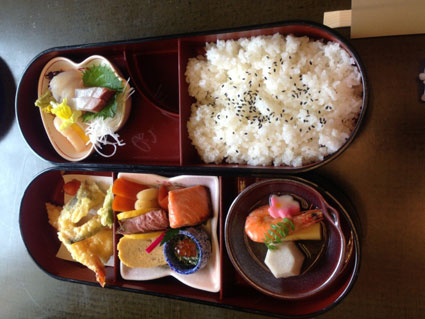Sakihana Onsen
Japanese Hot Springs: Sakihana Onsen - Touring Sakihanaonsen Village 咲花温泉
Greg Goodmacher
The best way to enjoy a rural Japanese hot-spring village in April is walking aimlessly, looking at cherry blossoms, perusing old buildings, and submerging oneself in at least two unhurried baths at a traditional Japanese onsen.
This was what we did after getting off a delightful steam locomotive that had brought us to the remote and tiny village of Sakihana Onsen, Niigata, a place renowned for cherry trees lining the train tracks and river.

Sakihana Onsen cherry blossoms above the train tracks, Niigata Prefecture.
The train pulled away, leaving us briefly wondering what to do first. We had a lunch reservation two hours later. The train station wasn't really a station. No station attendant was available to ask for information, or even to check our tickets. So we just walked along a small road that we guessed would take us to the main part of town.
We quickly spied a dozen or so men sitting on folding chairs under the enfolding branches of a cherry tree in the middle of a small farm plot. Each man held at least one camera and several long lenses. They were busy clicking photographs at the departing steam locomotive that we had just gotten off. From their perspective, the coal-black train would be framed by cherry blossom branches while some flowers drifted downward.
The miniscule road that we walked on brought us to the side of a river with several Japanese ryokan and a small park. By chance, we had arrived on the date of a special hanami party organized for the first time by several of the hotels and onsens within the village. We first noticed the smell of fish being grilled on charcoal. Then a variety of other scrumptious odors drifted on the soft breeze toward us.

Welcome to the Party, Sakihana Onsen, Niigata Prefecture.
Local residents enthusiastically asked us to partake in their lunchtime cherry-blossom viewing party. Several long tables displayed varieties of locally produced sake and food dishes made with vegetables grown in and around town: crisp myoga dashed with red miso, fried eggplant, sweet asparagus, soft fresh tofu, sautéed shitake mushrooms, and many more delicious dishes.
We were sorely tempted to join the party, especially since the tatami seating arrangements under cherry blossoms by the riverside were lovely. But we had previously reserved a special lunch at a nearby ryokan, so we promised to come again next year, and we wandered toward our lunch destination.

Cherry-Blossom Party in Sakihanaonsen, Niigata Prefecture.
However, we had to stop in our tracks when we came face to face with the local god, kamisama (神様), of health. He stood in a basic Shinto shrine on the side of the road. This god commanded one's attention. Taller than the average man, and with a penis that is larger than the average horse's appendage, one just had to pause, look, and ask people about the deity.
I learned that villages in certain areas along the Agano River make these gods once a year with rice straw. Villagers with health problems write notes about their ailments and the notes are interwoven with the straw. For example, the note written by someone with an injured knee is placed within the knee of the deity.

Local God, Sakihanaonsen, Niigata Prefecture.
Our lunch destination was a short walk away, and after having smelled and seen so much delicious food, we were ready for a quick hot spring bath followed by a feast. Satorikan (佐取館) is the name of the Japanese onsen where we had made our reservation.
Some ryokans offer special lunch and bath plans, and I had decided to indulge myself. For approximately 3,500 yen, or $35.00 US, (no tips and no taxes) we were allowed to enter the baths and to revel in our own private traditional Japanese dining room in which we were served a sumptuous Japanese meal.
On the Internet order form, we were asked if we were celebrating anything special. My wife wrote that we were celebrating my birthday. The waitress surprised us with a birthday gift of a humongous bowl of fresh strawberries, pineapple, melon, and other fruit.

Part of Our Gourmet Japanese Lunch, Niigata Prefecture.
When we first entered Satorikan, we were graciously served fresh green tea and given an explanation of the lunch plan. We were asked when we would like to eat, so that the hotel could have our lunch ready exactly when we wanted it. We decided to enjoy the baths before eating, and we went up to the top floor of the hotel for a bath.
From the man's bathing area, I could see the Agano River, various ridges still dappled with snow, a train track below, and lots of trees including Japanese cherry trees in full blossom. There was an indoor bath and an outdoor bath on a patio. After an hour of relaxation, my wife and I met back in our private room for our lunch feast. After lunch, we went back to the baths again.
With a few hours left before our return train to Niigata, we continued our ambling tour of Hanasaki Onsen. We got brochures from other ryokans, found a hiking trail that we did not have enough time to fully explore, and took one last bath before leaving. All in all, it was a satisfying day in a wonderful place to which I will return again.
Sakihana Onsen Access
From Niigata Station take the JR Shinetsu Line to Niitsu (20 minutes) and then the JR Ban-etsu-West Line to Sakihana (33 minutes). Tokyo Station to Niigata on the shinkansen is 2 hours and 5 minutes.
The author of this article blogs about Japanese hot springs at hotspringaddict.blogspot.jp.
Guide Books on Japan
Sakihana Onsen: read a guide to Sakihana Onsen in Niigata Prefecture known for its cherry blossom and excellent ryokan accommodation and cuisine.
















